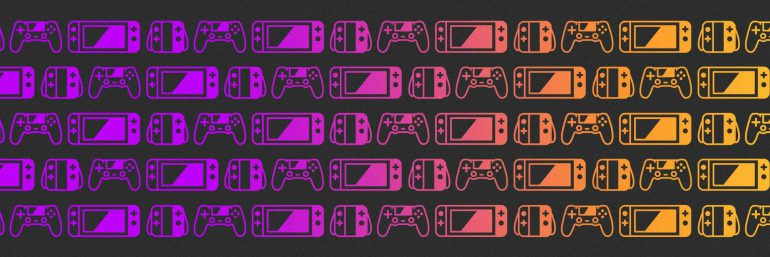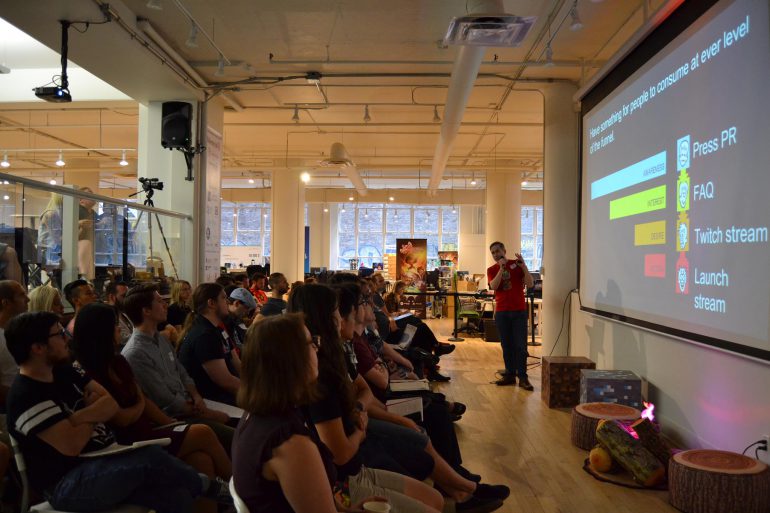
Project Overview
The Indie Interfaces: GPS / MESI IP Discoverability Engine Project, is a three-year collaborative grant and initiative between Concordia and GamePlay Space which launched in early 2018. The project, which developed out of the 2017 Indie Interfaces symposium and research group, has presented an interesting opportunity to bridge the gap between academic and industry interests and discussions. Founded in 2015, GamePlay Space or GPS is located in Montreal and is currently one of the largest game development co-working spaces in the world and is home to approximately 32 studios with over 100 individual members. GPS is similar to co-working spaces now typical for media and technology startups as a means of mitigating ‘precarity’ but it is hyper-specialized for indie game studios and developers.

The research side of the ‘Discoverability Engine’ aims to explore challenges related to visibility, attention, and sustainability that many independent game studios in Montréal face when developing and releasing a game. Working closely with the GamePlay Space team, the research involves a correlation of qualitative and quantitative onsite research in order to create comprehensive snapshots of each studio in the space, as well as the coordination of pedagogical events and initiatives aimed to help devs improve their business and marketing strategies. Data, information and analysis generated during this study will be used to help evaluate discoverability initiatives for indies as well as provide guidance and advice for future projects. Thus far, the research team is in the process of developing a paper called Indie Game Studios and the Attention Economy: On route to actually participatory media?, which was presented at MIT's Media in Transition Conference in May 2019, and will also be presented at DiGRA in Kyoto in August.

EXTENDED PAPER ABSTRACT
Is discoverability just another name for marketing? How are creators supposed to survive while precarity reigns and they are pitted against one another for an ever-decreasing slice of the pie, while ‘large platform intermediaries’ reap the profits? In a creative economy dominated by the condition of precarity, artists and cultural producers are finding that the savvy creation of unique content is not enough to ensure long term sustainability. In turn, they are forced to compete for what is perceived as the limited attention of audiences and consumers in an attention economy that is both a finite, exchangeable commodity and a necessary relation that offers access to others in the world (Ash, 2012). While Nancy Baym has charted this transformation in the work of musicians, we will tackle the problem in the context of independent video game developers and the varied approaches they take to capture and maintain the attention of potential consumers in a process known as ‘discoverability’. By drawing on interviews with twelve game development studios working out of an indie games co-working space called GamePlay Space (GPS) in Montréal, Canada, this paper reflects on how developers’ considerations of the players’ role in game design now melds with concerns over how those players will discover the game in the first place.
Citing Jenkins’ notion of ‘participatory culture’ (1992, 2006) and Banks’ exploration of videogame co-creation (2012), we determine that indie game audiences raise the potential for new kinds of relationality between traditionally conceived cultural producers and consumers in a model that is less about market attention and more about participation. Developers use platforms such as Discord, Twitch and Kickstarter to involve their communities in decision-making processes, game testing and community moderation, leading to the cultivation of fandom that often intersects with playbour (Kücklich, 2005). As a result, the traditional divide between producers and consumers, artists and audiences, has become less and less apparent in the indie ecosystem. While the discoverability discourse is often reducible to dominant forms of online product marketing and self-branding practices through social media, the case of games suggests that some interesting countervalent tendencies become evident. In reference to Baym’s work, we observe that game developers do not have the same cultural disposition to the relational labour of self-marketing that musicians typically do, yet at the same time, the medium of games necessitates the active participation of an audience beyond acts of consumption. Using Browne’s concept of indie labour as an effective as well as economic process where studios “recognize the importance and contributions of people and activities that would not otherwise be traditionally considered ‘part of the industry’” (74), we examine how developers strategically involve audiences in each stage of game development, often spanning several years.
This study is a part of a three-year research project, called The Indie Interfaces: MESI Quebec - GPS Discoverability Engine. The goal of this “Discoverability Engine” is to find ways to measure, track, and uncover key factors behind discoverability and the attention economy in the indie gaming industry in Québec. Founded in 2015, GamePlay Space or GPS is located in downtown Montréal and is home to approximately 32 studios with over 100 individual members, making it one of the largest game development co-working space in the world. GamePlay Space is similar to co-working spaces now typical for media and technology startups as a means of mitigating ‘precarity’, but it is hyper-specialized for indie game studios and developers. This gives it cultural intermediary functions (by hosting and organizing community events, playtest nights, publisher visits, etc..) that other coworking spaces do not have. In 2018 GPS won a grant from the Quebec Ministry of Economy & Innovation to develop programs for indie discoverability and our Concordia Indie Interfaces team partnered with GPS for the research portion of the grant.
The research conducted for this project has consisted of multiple stages over the last year and a half; including three rounds of focused interviews with the studios at the space, as well as with alumni studios based in Montréal. As a result, each stage of our research has presented increasingly robust and reflexive themes around the problem of discoverability. In this paper, we provide data from the emergent theme surrounding the relationship between player communities and game design. Our main findings have revealed that the communities that form around indie games and studios extend beyond forms of fandom seen in film, music and even AAA games. These communities are actively invited to join digital spaces in which they build interpersonal relationships with developers and are often asked for input on aspects of a game’s design and content. Further, the emergence of increasingly (inter)active modes of fandom outlined by most of the studios we interviewed, revealed the ways in which ‘superfans’ have emerged in these communities, taking on extensive moderation and testing responsibilities. Communities are contributing to the production of video games in extremely direct, ongoing, and intimate ways. The divide that usually exists between the cultural producer and consumer becomes less apparent, resulting in new levels of community participation and investment in a particular video game or studio. Independent game design is therefore now intertwined with practices of community moderation and cultivation in ways that are not reducible to social media marketing, impacting how games are conceived, created and played.
BIBLIOGRAPHY
Ash, James. “Attention, Videogames and the Retentional Economies of Affective Amplification.” Theory, Culture & Society, vol. 29, no. 6, Nov. 2012, pp. 3– 26. Crossref, doi:10.1177/0263276412438595.
Banks, John. Co-creating Videogames. London, UK: Bloomsbury Publishing, 2012. Baym, Nancy K. Playing to the Crowd: Musicians, Audiences, and the Intimate Work of Connection. New York University Press, 2018.
Browne, Pierson. Jumping the Gap: Indie Labour and the Imagined Indie Community. Montreal, Canada: Concordia University. 2015
Jenkins, Henry. Textual Poachers: Television Fans and Participatory Culture. New York: Routledge, 1992.
Jenkins, Henry. Convergence Culture: Where Old and New Media Collide. New York, NY: New York University Press, 2006.
Kücklich, Julian. "Precarious Playbour: Modders and the Digital Games Industry." Fibreculture Journal, 2005.
